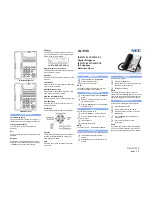
Administration
A31003-S2030-M100-11-76A9, 01/2015
296
OpenStage SIP V3R3 for OpenScape Voice, Administration Manual
administration.fm
Diagnostics
3.26.12.2
View Report
OpenStage phones generate QoS reports using a HiPath specific format, QDC (
Q
oS
D
ata
C
ol-
lection). The reports created for the last 6 sessions, i. e. conversations, can be viewed on the
WBM.
To enable the generation of reports, please ensure that:
•
the switch
QoS traps to QCU
(System > SNMP) is activated (see Section 3.3.9, “SNMP”);
•
the conditions for the generation of reports are set adequately (see Section 3.26.12.1,
“Conditions and Thresholds for Report Generation”).
For details about QoS reports on OpenScapeHiPath devices, see the HiPath QoS Data Collec-
tion V 1.0 Service Manual.
A QoS report contains the following data:
•
Start of report period - seconds
: NTP time in seconds for the start of the report period.
•
Start of report period - fraction of seconds
: Additional split seconds to be added to the
seconds for an exact start time.
•
End of report period - seconds
: NTP time in seconds for the end of the report period.
•
End of report period - fraction of seconds
: Additional split seconds to be added to the
seconds for an exact end time.
•
SNMP specific trap type
: The trap type is a 5 bit value calculated from a list of threshold-
exceeding bits. Every time a threshold is exceeded, the associated bit is set, otherwise it
is cleared.
The trace type bits are defined as follows:
•
Bit 0: Jitter threshold was exceeded.
•
Bit 1: Delay threshold was exceeded.
•
Bit 2: Threshold for lost packets was exceeded.
•
Bit 3: Threshold for consecutive lost packets was exceeded.
•
Bit 4: Threshold for consecutive good packets was exceeded.
•
IP address (local)
: IP address of the local phone.
•
Port number (local)
: RTP receiving port of the local phone.
•
IP address (remote)
: IP address of the remote phone that took part in the session.
•
Port number (remote)
: RTP sending port of the local phone.
•
SSRC (receiving)
: RTP Source Synchronization Identifier of the local phone.
•
SSRC (sending)
: RTP Source Synchronization Identifier of the remote phone.
•
Codec
: Number of the Payload Type applied in the session; see RFC 3551 (Table 4 and 5).
•
Maximum packet size
: Maximum size (in ms) of packets received during the report inter-
val.
•
Silence suppression
: Number of silence suppression activation objects found in the RTP
stream received. A silence suppression activation object is defined as a period of silence
when no encoded voice signals were transmitted by the sender.
•
Count of good packets
: Total amount of good packets.
















































